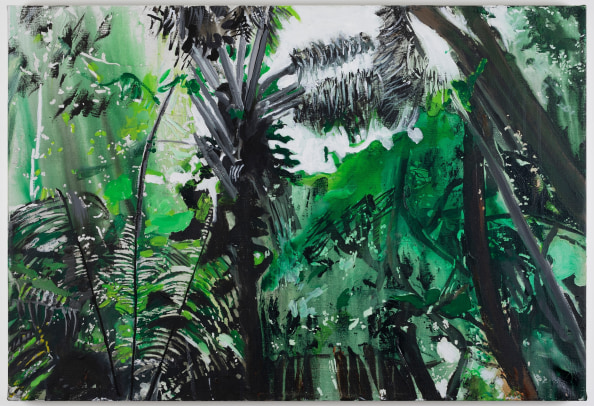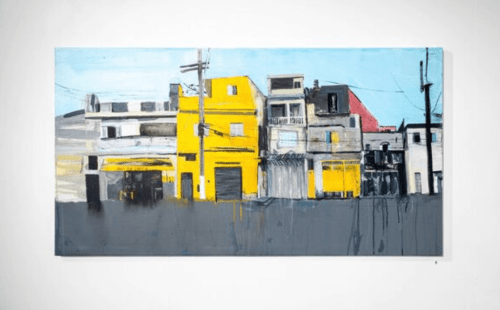

Valdemar Cordeiro dos Santos was two years old when his family moved 1,000 miles south from rural Bahia to settle in the favelas of Sao Paulo, the most populous city in Brazil. He picked coffee beans for a living before discovering he had an aptitude for electronics, and set up in business repairing radios and televisions. As he and his wife Valderci reared their family, he built them a three-storey home in the suburb of Jabaquara.
The construction project has in turn inspired Then I Laid the Floor, the exhibition by his son-in-law, James Concagh, Brian Maguire and Robert Chase Heishman that is currently showing at the Triskel Arts Centre in Cork. The exhibition was originated by Concagh, who graduated from the National College of Art and Design in Dublin and emigrated to Brazil in 1988.
There, he married and had two sons with a local girl he’d met in Dublin, and he chose to stay on in Sao Paulo when they split up. “I loved Brazil, and I wanted to be near my sons,” he says. “I remarried twenty years ago, to Andrea, who is Valdemar and Valderci’s daughter, and we have a boy who’s sixteen. In Sao Paulo, I’ve got by as a teacher; I’m giving a course in art in an international school at the moment. And then I have my studio time, where I work on my art.”
As Concagh describes it, Sao Paulo is a city of contrasts. Downtown are the monumental Modernist buildings designed by the Rio de Janeiro architect Oscar Niemeyer; on the outskirts of the city are the houses that families, over many generations, have fashioned for themselves out of whatever materials are at hand. Concagh has adopted a similar approach to his art-making; he trained as a sculptor, but found himself experimenting with painting in Brazil, developing a process that involves him layering paint and other materials on the canvas.
“It comes about through doubt,” he says. “I’ve never been quite sure about anything, particularly painting. I think that’s reflected in this project about Valdemar’s house. It’s about the idea of things being fragile; I see the fragility of a family trying to get by, and I want to show that, but in an abstract form. So my work is about the idea of building blocks that don’t quite fit together."
Concagh met Maguire, another Irish artist, in 1998, when he was working on a three-month residency at the college Concagh was teaching in at the time. They struck up a friendship, but it was not until the Covid pandemic that Concagh suggested they collaborate on a project.
“In the lockdowns, there were no exhibitions,” he says. “All the cultural activities in Sao Paulo were put to one side. But I saw these paintings online that Brian had done in Aleppo, in Syria, paintings of the facades of buildings, and I thought it amazing that they could be so much about the human condition. I wanted to celebrate Valdemar’s dignity, so I thought I’d invite Brian to paint his house; I thought it important to give value to a structure built by Valdemar’s own hands.”
As the project developed, it was Maguire who suggested that Heishman become involved as well. Based in Chicago, Heishman works in a variety of media, including filmmaking. The three convened in Sao Paulo to see how they might collaborate, and it was agreed that Heishman would direct a short film, The House That Valdemar Built, that could be shown alongside Concagh and Maguire’s paintings.
“James, Brian and I spent close to two weeks together in Sao Paulo,” says Heishman. “We spent time with Valdemar and his family, and essentially we were part of the daily activity in the house, which was really special. I think that’s why I was able to capture certain footage for my film that I wouldn’t have gotten by going there on scheduled times. You know, you have one of Valdemar’s grandchildren, Isabella, dancing to K-pop from YouTube. That was really surprising to me, and that made it into the film because I felt it spoke to the future of the family.”
Heishman was aware of the cultural responsibility that comes with being an outsider filming in Sao Paulo. “I grew up in the Midwest of the United States,” he says, “so initially, I struggled to feel comfortable engaging with this subject of life in a favela. But I soon found a deep connection in the story of Valdemar, who, like my father, laid bricks and was also a builder. So, that was a story that compelled me, not just from the standpoint of telling the story of this family in Sao Paulo, but also because I was able to engage with my own family lineage."
Concagh’s hopes for Then I Laid the Floor is that it will tour to Sao Paulo once it finishes its run in Cork.
“I’m in contact with a gallery owner here, and she’s very keen on it,” he says. “I’ve already shown at her gallery, so she knows my work. And she’s met Brian and Robert. It will be nice that we can bring Valdemar and Valderci to see the exhibition.”